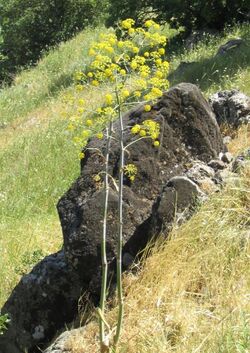Biology:Ferula
| Ferula | |
|---|---|

| |
| Ferula communis | |
| Scientific classification | |
| Kingdom: | Plantae |
| Clade: | Tracheophytes |
| Clade: | Angiosperms |
| Clade: | Eudicots |
| Clade: | Asterids |
| Order: | Apiales |
| Family: | Apiaceae |
| Subfamily: | Apioideae |
| Tribe: | Scandiceae |
| Subtribe: | Ferulinae |
| Genus: | Ferula L. |
| Synonyms[1] | |
|
List
| |
Ferula (from Latin ferula, 'rod') is a genus of about 220 species of flowering plants in the family Apiaceae, native to the Mediterranean region east to central Asia, mostly growing in arid climates. They are herbaceous perennial plants growing to 1–4 m tall, with stout, hollow, somewhat succulent stems. The leaves are tripinnate or even more finely divided, with a stout basal sheath clasping the stem. The basal sheaths of Ferula oopoda are up to six inches (15 cm) long and form a cup holding about a cup of rainwater,[2] possibly to draw pollinators in an arid land. The flowers are usually yellow, rarely white, produced in large umbels. Many plants of this genus, especially F. communis, are referred to as "giant fennel," although they are not fennel in the strict sense.[3][4]
Selected species
The Roman spice laser or laserpicium probably came from a species of Ferula, either an extinct one or Ferula tingitana, though other identities have been suggested.
Uses

The gummy resin of many species of Ferula is used for various purposes:
- :Ferula foetida, Ferula assa-foetida and some other species are used to make the spice asafoetida, or hing[6]
- :Ferula gummosa makes galbanum
- :Ferula hermonis makes zallouh
- :Ferula moschata makes sumbul
- :Ferula persica or F. szowitziana makes sagapenum
- :Ferula marmarica makes "Cyrenaican ammoniacum"
- :Ferula ammoniacum makes "Persian ammoniacum"
- :Ferula communis subsp. brevifolia makes "Moroccan ammoniacum"
- :Silphium was used to make laserpicium
The Romans called the hollow light rod made from this plant a ferula (compare also fasces, judicial birches). Such rods were used for walking sticks, splints, for stirring boiling liquids, and for corporal punishment.[citation needed]
References
- ↑ "Ferula Tourn. ex L.". Board of Trustees of the Royal Botanic Gardens, Kew. 2017. http://powo.science.kew.org/taxon/urn:lsid:ipni.org:names:30105171-2#synonyms.
- ↑ T.I. Agagmuradov, Badghiz, (1984)p. 187
- ↑ Altervista Flora Italiana, genere Ferula
- ↑ Flora of Pakistan, Ferula Linn
- ↑ Bulfina, Ovidiu. "Discovery! New plant species in Romania". http://www.birdlife.org/europe-and-central-asia/news/discovery-new-plant-species-romania.
- ↑ Plants for a Future, Ferula assa-foetida L., Asafoetida - Devil's Dung. Hing
External links
Wikidata ☰ Q1342970 entry
 |



